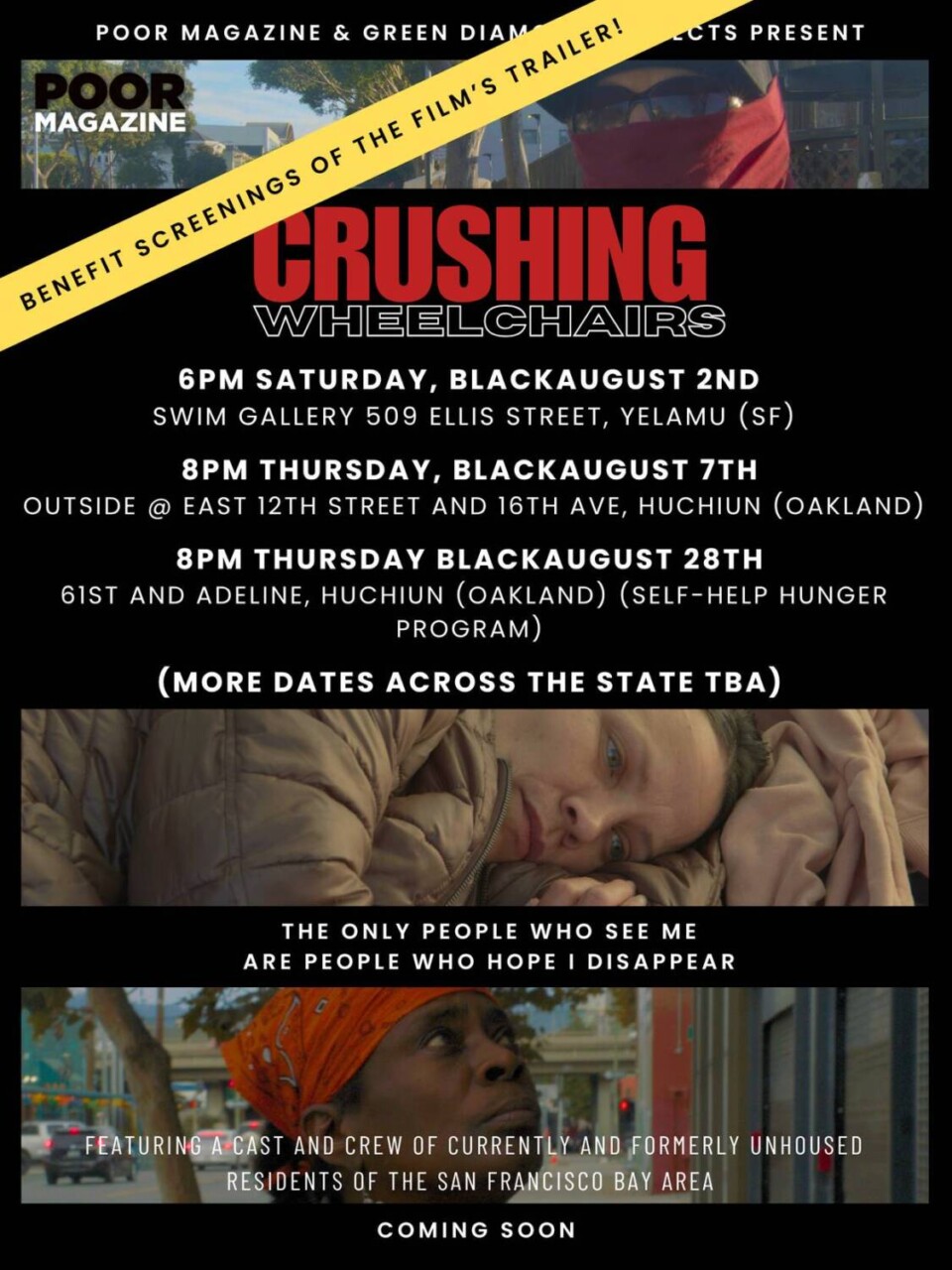
by Lisa ‘Tiny’ Gray-Garcia
While the U.S. government signs an executive order to literally disappear houseless comeUnities from cities across the nation, a powerful new movie is created by houseless and formerly houseless artists, cultural workers, poets and survivors that tells the stories of the people Trump is trying to disappear.
Benefit screenings of the trailer:
- 6 p.m. Saturday, BlackAugust 2nd, Swim Gallery, 509 Ellis St., San Francisco
- 8 p.m. Thursday, BlackAugust 7th, Outside at East 12th Street and 16th Ave, the site of one of the most violent “sweeps” of one of the largest street comeUnities in Oakland
- 7 p.m. Thursday, BlackAugust 14th with WRAP’s art and organizing event at Eric Quesada Center, 518 Valencia, SF
- 8 p.m. Thursday, BlackAugust 28th, Outside at 61st and Adeline streets at the Self-Help Hunger Program
- More dates across the state to be announced
“That’s my wheelchair!” Reggie, a disabled Black elder, screams at a bulldozer coming for her comeUnity and her wheelchair.
“Crushing Wheelchairs,” with an original screenplay by houseless poet and povertyskola Tiny Gray-Garcia, adapted from her award-winning play of the same name, focuses on the violence of homelessness, city and state sponsored sweeps, and poLice terror. The movie includes an all-houseless and formerly houseless cast whose motto is: “We aren’t acting, We are living.” It was shot primarily in houseless communities (encampments) and on the streets in Oakland and San Francisco.
The story of “Crushing Wheelchairs” is written in a prayer, a dream, and a scream felt and barely survived by me, Tiny Gray-Garcia, aka povertyskola, my houseless, disabled mama, and all of my fellow poverty and disability skolaz and ancestors portrayed and lived in this movie story. This is the art of our lives, our almost survival, and our death at the hands of laws that say our bodies and lives are criminal and that we are trash.
The lead characters in this powerful movie feature Tiny and her mother, who struggled with homelessness throughout Tiny’s childhood and later were arrested for sleeping on the streets of Oakland; Aunti Frances Moore, a formerly houseless Black Panther in Oakland; Stephanie Grant, who was pregnant and homeless when she witnessed the murder of Luis Gongora Pat by poLice in 2016 for being houseless and indigenous in a rapidly gentrifying San Francisco Mission neighborhood.
The ancestors of homelessness we also focus on include Steven Taylor, murdered by poLice in Walmart while houseless for having a mental health crisis; Papa Bear, a houseless veteran of three tours in Vietnam, who died on the streets of San Francisco after receiving 280 citations for being houseless on the street; Iris Canada, a 100-year-old Black Elder evicted to homelessness from her longtime home in the Fillmore due to gentrification; Shannon Marie Bigley, Cornelius Taylor and James Edward Oakley, all run over by bulldozers in sweeps of their tents in California and Atlanta; Anjileen “Green Eyes” Swan, who died after being violently swept in Los Angeles; and Luis Temaj, burned alive while asleep in his sleeping bag – and so many more.
We are living in a moment when the U.S. president just signed an executive order to disappear houseless peoples’ bodies and comeUnities off the streets by force. In addition, he is cutting all of our housing and treatment resources which further enhanced already dangerous sweeps that were amped up by last year’s Supreme Court ruling that stated living while houseless in the U.S. is a crime (City of Grants Pass vs. Johnson, 2024) and that houseless people have no protection under the Constitution – and that this crime is punishable by arrest and incarceration.
But how can you incarcerate someone for being poor, for being disabled, for not having enough money or credit to pay rent to attain shelter? How can we be punished for living outside without access to shelter, for being poor?
In the state of California, the governor has claimed that our bodies are equivalent to trash. In the City and County of San Francisco, the mayor has deemed our presence a blight; and in Los Angeles where, on average, six unhoused people die every day, our outside comeUnities (encampments) are being destroyed, evicted and disappeared. Our lives are now deemed unworthy of human rights, so I suppose in the eyes of the state we are not human; we are in fact trash.
“But we are not trash. This movie at this time is urgent medicine for humanity itself, who through this art can realize that we as houseless people are just like housed people. We are workers and artists and poets and innovators – and survivors. We have solutions and backstories and HERstories and visions! This movie lifts up those urgent stories, those urgent solutions – this movie is medicine for Mama Earth and all of us,” concludes Tiny Gray-Garcia.
The movie, produced by Green Diamond Projects and POOR Magazine, includes renowned poets Tongo Eisen-Martin, Ayodele “Wordslangar” Nzinga, Luis Rodriguez and Devorah Major, as well as indigenous leaders and prayer-bringers Corrina Gould, Tony Gonzales, OG Rev. Harry Williams and Brother Mink, as well as formerly houseless leaders from Wood Street Commons and Homefulness.
Lisa “Tiny” Gray-Garcia, aka “povertyskola,” is a poet and teacher and the formerly houseless, incarcerated daughter of Dee and mama of Tiburcio, author of “Criminal of Poverty: Growing Up Homeless in America” and many more and co-founder of Homefulness, a homeless people’s solution to homelessness. Reach her at www.lisatinygraygarcia.com or @povertyskola on Twitter/X.




